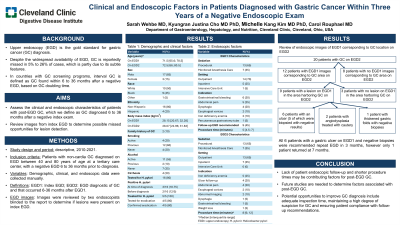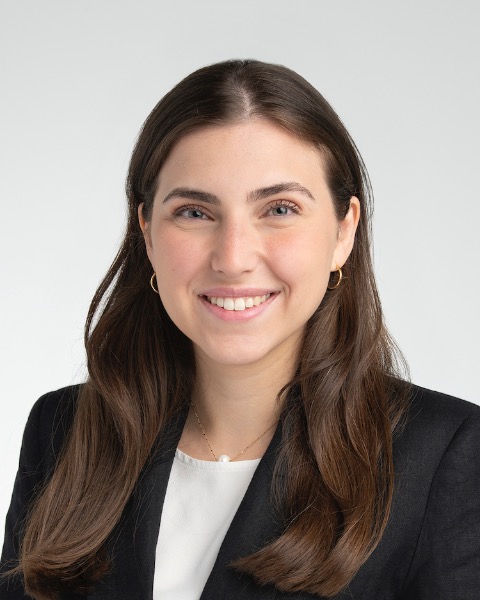Sunday Poster Session
Category: Stomach
P1602 - Possible Missed Opportunities in Gastric Cancer Diagnosis: Clinical and Endoscopic Factors in Patients Diagnosed with Gastric Cancer Within Three Years of a Negative Exam
Sunday, October 27, 2024
3:30 PM - 7:00 PM ET
Location: Exhibit Hall E

Has Audio

Sarah Wehbe, MD
Cleveland Clinic
Cleveland, OH
Presenting Author(s)
Sarah Wehbe, MD1, Kyungran Justina Cho, MD, PhD2, Michelle Kang Kim, MD, PhD1, Carol Rouphael, MD2
1Cleveland Clinic, Cleveland, OH; 2Digestive Disease Institute, Cleveland Clinic, Cleveland, OH
Introduction: Upper endoscopy (EGD) is the gold standard for gastric cancer (GC) diagnosis. Despite the widespread availability of EGD, GC is reportedly missed in 5% to 26% of cases, partly due to its subtle features. We assess the clinical and endoscopic characteristics of patients with post-EGD GC, defined as GC diagnosed 6 to 36 months after a negative index exam, and review images from index EGD to determine possible missed opportunities for neoplastic lesion detection.
Methods: Non-cardia GC cases 40 to 80 years diagnosed on EGD at a tertiary care center between 2010 and 2021 with a negative EGD 6 to 36 months prior were included. EGD1 was defined as negative index EGD and EGD2 as EGD diagnostic of GC. Demographic, clinical, and endoscopic data were collected. EGD1 and EGD2 images were reviewed by two endoscopists blinded to the report to determine if suspicious lesions were present on EGD1. Descriptive statistics were used.
Results: Of 716 non-cardia GC patients within the study period, 20 patients were included (Table). Median diagnosis age was 72.5 years [Interquartile range (IQR) 66; 80.5], 85% were male and 50% were White. Median procedure time was 5 minutes [IQR 4.5;7] for EGD1 and 8 minutes [IQR 6;12] for EGD2. Median time from EGD1 to EGD2 was 16 months [IQR 9;21]. Only 12 patients had an EGD1 image corresponding to the GC area on EGD2. Of those, 9 were identified as having a lesion on EGD1 in the area harboring the GC on EGD2. 6 of those had an ulcer on EGD1 (5 of which were biopsied with negative results), 2 had angiodysplasias treated with cautery, and 1 had thickened gastric folds with negative biopsies. The other 3 patients had no lesions at the corresponding site on EGD1. All 6 patients with an ulcer on EGD1 and negative biopsies were recommended repeat EGD in 3 months, however only 1 returned at 7 months.
Discussion: Our findings suggest potential opportunities to improve diagnosis of GC. These include adequate inspection time, high degree of suspicion for GC, and ensuring patient compliance with follow-up recommendations.
Note: The table for this abstract can be viewed in the ePoster Gallery section of the ACG 2024 ePoster Site or in The American Journal of Gastroenterology's abstract supplement issue, both of which will be available starting October 27, 2024.
Disclosures:
Sarah Wehbe, MD1, Kyungran Justina Cho, MD, PhD2, Michelle Kang Kim, MD, PhD1, Carol Rouphael, MD2. P1602 - Possible Missed Opportunities in Gastric Cancer Diagnosis: Clinical and Endoscopic Factors in Patients Diagnosed with Gastric Cancer Within Three Years of a Negative Exam, ACG 2024 Annual Scientific Meeting Abstracts. Philadelphia, PA: American College of Gastroenterology.
1Cleveland Clinic, Cleveland, OH; 2Digestive Disease Institute, Cleveland Clinic, Cleveland, OH
Introduction: Upper endoscopy (EGD) is the gold standard for gastric cancer (GC) diagnosis. Despite the widespread availability of EGD, GC is reportedly missed in 5% to 26% of cases, partly due to its subtle features. We assess the clinical and endoscopic characteristics of patients with post-EGD GC, defined as GC diagnosed 6 to 36 months after a negative index exam, and review images from index EGD to determine possible missed opportunities for neoplastic lesion detection.
Methods: Non-cardia GC cases 40 to 80 years diagnosed on EGD at a tertiary care center between 2010 and 2021 with a negative EGD 6 to 36 months prior were included. EGD1 was defined as negative index EGD and EGD2 as EGD diagnostic of GC. Demographic, clinical, and endoscopic data were collected. EGD1 and EGD2 images were reviewed by two endoscopists blinded to the report to determine if suspicious lesions were present on EGD1. Descriptive statistics were used.
Results: Of 716 non-cardia GC patients within the study period, 20 patients were included (Table). Median diagnosis age was 72.5 years [Interquartile range (IQR) 66; 80.5], 85% were male and 50% were White. Median procedure time was 5 minutes [IQR 4.5;7] for EGD1 and 8 minutes [IQR 6;12] for EGD2. Median time from EGD1 to EGD2 was 16 months [IQR 9;21]. Only 12 patients had an EGD1 image corresponding to the GC area on EGD2. Of those, 9 were identified as having a lesion on EGD1 in the area harboring the GC on EGD2. 6 of those had an ulcer on EGD1 (5 of which were biopsied with negative results), 2 had angiodysplasias treated with cautery, and 1 had thickened gastric folds with negative biopsies. The other 3 patients had no lesions at the corresponding site on EGD1. All 6 patients with an ulcer on EGD1 and negative biopsies were recommended repeat EGD in 3 months, however only 1 returned at 7 months.
Discussion: Our findings suggest potential opportunities to improve diagnosis of GC. These include adequate inspection time, high degree of suspicion for GC, and ensuring patient compliance with follow-up recommendations.
Note: The table for this abstract can be viewed in the ePoster Gallery section of the ACG 2024 ePoster Site or in The American Journal of Gastroenterology's abstract supplement issue, both of which will be available starting October 27, 2024.
Disclosures:
Sarah Wehbe indicated no relevant financial relationships.
Kyungran Justina Cho indicated no relevant financial relationships.
Michelle Kang Kim indicated no relevant financial relationships.
Carol Rouphael indicated no relevant financial relationships.
Sarah Wehbe, MD1, Kyungran Justina Cho, MD, PhD2, Michelle Kang Kim, MD, PhD1, Carol Rouphael, MD2. P1602 - Possible Missed Opportunities in Gastric Cancer Diagnosis: Clinical and Endoscopic Factors in Patients Diagnosed with Gastric Cancer Within Three Years of a Negative Exam, ACG 2024 Annual Scientific Meeting Abstracts. Philadelphia, PA: American College of Gastroenterology.
